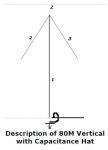80M Vertical Antenna with Capacitance Hat
- Simple wire antenna;
- Cheap to make, using readily available materials;
- Low angle radiation, with rejection of high angle signals;
- Wide bandwidth, with resonance at the 80M DX window (3.790-3.800 MHz); and
- Maximum height is 40 feet (limitation due to treeheight).
Design:
Since the use of a full ¼-wave vertical was out of the question because of space reasons, it was decided to use a smaller vertical, and load the top portion of the antenna with a capacitance hat. Based on modeling results, the following dimensions satisfied the design requirements:
Wire Lengths of Antenna Described for 3.800 Mhz
Wire Number Length Included AngleThe nylon lines connecting wires #2 and #3 to the ground are 6.58 m (21’-7”) from the
1 11.89 m (39') N/A
2 5.84 m (19'-2") 29º
3 5.84 m (19'-2") 29º
vertical wire #1. This makes the determining the angle moot, and simplifies installation.
Model:
The model was made in MMANA, with 200 segments per wire. Real ground was modeled, ith a dielectric strength of 1.0 and an earth conductivity of 1.0 mS/m – very poor
conductivity. The model included 3 radials, approximately 5 m long. results of the model are shown attached.
Results:
After erecting the antenna, and driving in a 12mm copper ground rod, measurements were taken prior to attachment of radials. The resistance was very high. Radials were attached, and the measurements were retaken using a MFJ-259 SWR Analyzer. The results showed resonance at 3.720 MHz, with no tuning required. The 1.5:1 bandwidth was 3.620-3.82 MHz, or approximately 200 KHz. The band width definition of 1.5:1 was chosen to allow the use of an amplifier.
After a period of time it was noticed that the SWR crept up from 1:1 at 3.720 to approximately 1.3:1 at 3.825 MHz, with no changes to the antenna. Examining the change with an MFJ-259 SWR Analyser, it was found that the antenna had reduced capacitance, resulting in a shift in the resonance, and an increase in SWR. Since the antenna was hung rom a tree, and the antenna was erected when leaves were still on the trees, it is suspected that the presence of leaves increased the effective capacitance of the antenna.
When the leaves fell for the winter, the capacitace effect was reduced, and the SWR increased. Also, the moisture of the ground in August when the antenna was erected was ery low. In November, substantial rain occurred, resulting in better ground conductivity.
This had the effect of increasing the resonance, and broadening the 1.5:1 SWR range. So it is expected that the curves will return to the original SWR once leaves appear on the trees again. The SWR curves of the antenna are on picture 3.
On-the-air results were gratifying. Using an Icom-756Pro, and AL-80A, running 500 watts, I was able to work Sweden, England, Germany, Ukraine, Belarus, Russia, Bulgaria, Slovenia, Poland, Hungary, and other Europeans on a single call, during the Worked all Europe
Contest. Recently, during evening, at the greyline, using 800 watts (and no special receive antenna), I was able to work Diego Garcia (VQ9) and Austrailia (VK6). Hong Kong, Japan
and South Korea were also heard (but not worked) long path. During the CQWW SSB Contest, working only evenings, I was able to work 75 countries. Not bad for a $7 US wire
vertical. Each gave good signal reports, with some even commenting on the strength of the signal.




No comments:
Post a Comment